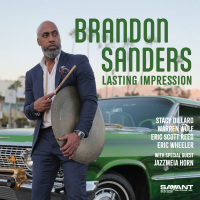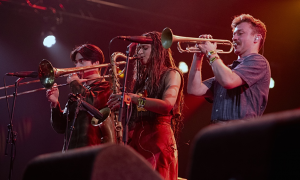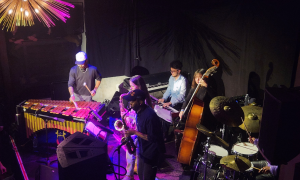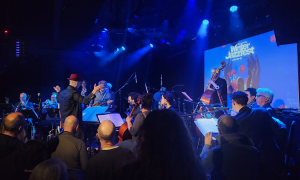Home » Jazz Articles » Live Review » Count Basie?s Centennial Celebration
Count Basie?s Centennial Celebration
The Hollywood Bowl
Hollywood, California
July 28, 2004
Everybody thought the Basie band would be playing all those familiar songs that left their imprint on jazz history. After all, The Count Basie Orchestra, by design, intends to carry on the tradition that its leader created decades ago.
What transpired Wednesday night at the Hollywood Bowl, was a combination of the new and the old. The band has grown, and its repertoire has expanded. That Basie sound , however, hasn't faded one bit. Big band arrangements by Sammy Nestico, Bill Holman, Bob Ojeda, and current band member Doug Miller hold the band securely to those traditional Basie roots. You can feel it in your bones, and this band swings with the same spirit that Count Basie espoused.
What was missing Wednesday, however, was the incredible change in dynamics that the original Basie band used to exploit. Remember how you'd be lulled into a quiet, drifting moment, when - all of a sudden - pow! The band would wake you up with musical punctuation designed to format each piece just right.
The current orchestra includes several veterans who played with Count Basie. Trombonist Clarence Banks, baritone saxophonist John Williams, drummer Butch Miles, and bassist James Leary performed with the"Li'l Ol' Groovemaker" prior to his death in 1984. The rest of the band consists of: conductor Bill Hughes, trumpeters Mike Williams, Scotty Barnhart, Shawn Edmonds & Endre Rice, trombonists Alvin Walker, David Keim & Barry Cooper, alto saxophonists John Kelson & Marshall McDonald, tenor saxophonists Doug Miller & Doug Lawrence, guitarist Will Matthews, pianist Tony Suggs and vocalist Chris Murrell.
The first set, which consisted of "The Wind Machine," "The Vine Street Ramble," "Paris Blues," "Too Close for Comfort," "Every Day I Have the Blues," "Please Be Kind," "Please Send Me Someone to Love" and "The Drum Thing," included three vocal numbers by Murrell. Youthful in appearance and easy to follow musically, he was able to charm the audience without lingering in the shadow of Joe Williams. While the performance included a lot of soloing up front at the microphone, the standout performances came from only a few: trumpeters Barnhart & Edmonds, pianist Suggs, and bassist Leary, who carried his upright model up to the front of the stage for his spirited contribution.
During the intermission, black and white photos by William Claxton were shown on the stadium's four giant screens. It was only a portion of the noted jazz photographer's collection, but most of the audience recognized Miles Davis looking at the camera, Chet Baker with Helima, Dinah Washington, Ornette Coleman, Louis Armstrong, Ben Webster with Gerry Mulligan, and Birdland at 4:00 a.m., 1960 in New York City.
The second set featured four guest vocalists who each sang three songs with the band. Dianne Reeves performed "Lullaby of Birdland," "Skylark" and "That's All" with the band. Her wordless vocal solo, a swinging piano solo by Peter Martin, and a spirited trumpet solo by Barnhart marked the evening's high points.
Ernestine Anderson performed "One Mint Julep," "The Street of Dreams" and "Make Your Move Too Soon." At 75, she proved the great storyteller, entertaining the audience with expressive comments about the way we live our lives.
Jon Hendricks sang "Get Me to the Church on Time," "The September Of My Years" and his own "The Satellite Blues." At 82, he's able to charm an audience as he did with Louis Jordan in '52 and with Lambert, Hendricks & Ross shortly thereafter. His decision to sing one song from that earlier period, one soulful ballad, and one new and contemporary composition, served to summarize the career of a master. Vocalese is his specialty, and he seems to get better every year.
Diane Schuur performed "Deedles Blues," "We'll Be Together Again" and "Tryin' to Get Home" with the band. Her articulate manner and forceful projection continue to be great crowd-pleasers. As she goes up high consistently, she proves that her voice is in perfect form.
Everyone came together for the final number, a blues jam session that featured all five vocalists doing their solo thing up front. Each sang a portion, and then they grouped together for a vocal jam that made the blues come alive. Count Basie would have been proud.
Tags
PREVIOUS / NEXT
Support All About Jazz
 All About Jazz has been a pillar of jazz since 1995, championing it as an art form and, more importantly, supporting the musicians who make it. Our enduring commitment has made "AAJ" one of the most culturally important websites of its kind, read by hundreds of thousands of fans, musicians and industry figures every month.
All About Jazz has been a pillar of jazz since 1995, championing it as an art form and, more importantly, supporting the musicians who make it. Our enduring commitment has made "AAJ" one of the most culturally important websites of its kind, read by hundreds of thousands of fans, musicians and industry figures every month.























